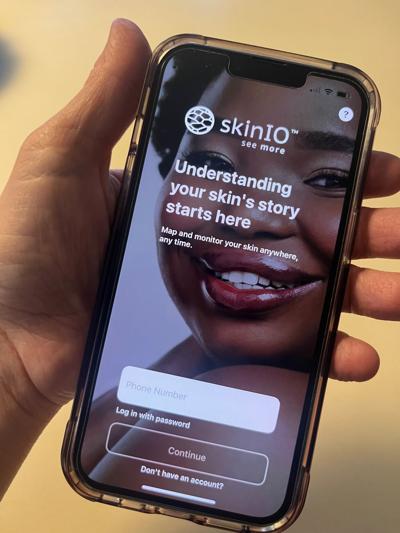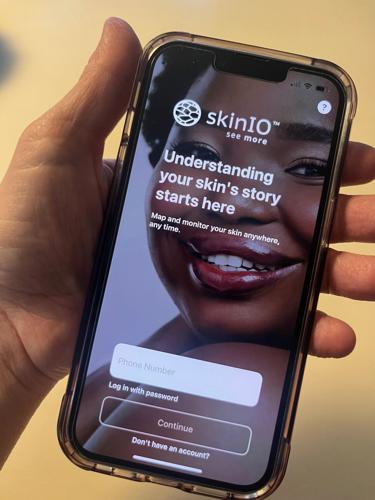The rising use of artificial intelligence has the potential to remake society, for better and worse. But one Chicago company, with ties to Lancaster, is using that powerful technology for good by helping to detect skin cancer in its early stages.
The SkinIO smartphone app allows users to take photos of their skin in 10 minutes. These images are reviewed by a dermatologist who determines whether any concerning spots merit further examination. If so, a follow-up appointment with a dermatologist is recommended, with guidance on finding a doctor. For repeat users, the app provides baseline photos to be compared with later photos for any suspicious skin changes.
“Your skin is your most visible organ, right? You see it every day,” says Kyoko Crawford, SkinIO’s co-founder and CEO. “You see it when you’re putting on makeup, when you’re shaving, when you’re getting dressed. But very few of us take the time to actually look.”
She adds, “SkinIO helps you look, truly look at your skin. And it’s worth your time to look at your skin because you could catch something early that could change your life.”
READ: Full coverage of Progress 2024 [roundup]
Lancaster pilot program
In 2022, SkinIO’s app was refined at Lancaster’s Smart Health Innovation Lab, which describes itself as a “market adoption accelerator for health care technologies.” The iLab chose SkinIO for its residency program, which focused that year on developing innovations in tele-dermatology.
Pilot screening programs were held with several Lancaster-area employers, including Aspire Ventures and Signature Custom Cabinetry. Crawford describes those screening programs, involving a few hundred people, as “immensely helpful.”
Citing the Skin Cancer Foundation, SkinIO’s website (skinio.com) notes that 70% to 80% of melanomas appear as new spots while 20% to 30% arise from changes to existing moles. Malignant melanoma is the deadliest form of skin cancer; other forms include basal cell and squamous cell carcinomas. According to the foundation, skin cancer is the most common cancer in the United States and worldwide, and one in five Americans will develop it by age 70.
“Just tracking spots you know about is not necessarily enough,” Crawford says. “The vast majority will come from a spot that wasn’t there before, so if you don’t notice that it shows up, you may miss that early warning.”
READ: How AI helps hospitals keep a watchful eye on patients
The app uses AI and machine learning to analyze what is known as total body photography, in which as much of a patient’s skin as possible is photographed. The use of total body photography in dermatology is not new but hasn’t been widely accessible, Crawford says.
SkinIO’s technology helps a doctor spot any skin changes more easily in less time. The AI analyzes “regional images” and highlights any “outliers” that look dramatically different from an individual’s average spots, she says.
It’s what dermatologists call the “ugly duckling model,” Crawford says. A dermatologist, who may see dozens of patients a day, is not looking at a patient’s skin “freckle by freckle, mole by mole” but rather is checking for changes to that patient’s typical pattern of skin markings.
And if someone has a lot of freckles and returns for a follow-up skin exam in a year, or three or five years, it could be difficult for even these expert specialists, who may see thousands of patients a year, to detect any potentially harmful changes, she says.
Adults should have their skin examined once a year, and those previously diagnosed with skin cancer should do so every six months, Crawford says. But wait times to see a dermatologist can be long, with what she describes as a “pretty pronounced scarcity of dermatologists in this country.”
The future of SkinIO
The SkinIO technology is not diagnostic. AI is “able to process that information really quickly, but the judgment, from the clinical expertise, the empathy, all of that should come from a human dermatologist,” Crawford says.
The technology has allowed previously untapped patient populations to receive dermatological care, while compiling data from more diverse demographic groups, Crawford says. And while the use of AI in health care is “super exciting,” she says, it must be done responsibly.
Crawford started SkinIO in 2014 with Dr. JC Lapiere, a Chicago dermatologist and surgeon who co-founded the Northwestern Skin Cancer Institute. Lapiere had saved the life of Crawford’s father-in-law from melanoma — twice.
Crawford, with a background in biomedical engineering, had founded and ran a New York City-based technology development consultancy before launching SkinIO.
SkinIO, which uses a network of dermatologists licensed in 35 states, is not currently marketed to the general public. Instead, it’s mainly available as a health care benefit through an employer or union, Crawford says. So, while the app can be found on GooglePlay and the App Store, an organization code is needed to access it.
However, possible development as a direct-to-consumer product is “certainly on the roadmap,” she says.







 LISA SCHEID | Business Trends Reporter
LISA SCHEID | Business Trends Reporter

